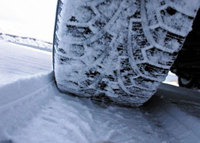Cold weather tyres offer motorists a safer alternative this winter
 With winter fast approaching, TyreSafe is advising motorists to consider fitting cold weather tyres in order to improve road safety and reduce the number of accidents on the road. Despite the change in road conditions at the onset of winter, many drivers continue to drive on standard tyres. Slippery roads accounted for 55 percent of road traffic accidents in which road environment was a contributory factor in 2007, according to Department for Transport (DfT) figures. In November 2007, the DfT recorded a spike in personal injury accidents as drivers were caught out by the drop in temperature and increased rainfall, with 16,559 accidents recorded, nearly 700 more accidents than at any other time in the year.
With winter fast approaching, TyreSafe is advising motorists to consider fitting cold weather tyres in order to improve road safety and reduce the number of accidents on the road. Despite the change in road conditions at the onset of winter, many drivers continue to drive on standard tyres. Slippery roads accounted for 55 percent of road traffic accidents in which road environment was a contributory factor in 2007, according to Department for Transport (DfT) figures. In November 2007, the DfT recorded a spike in personal injury accidents as drivers were caught out by the drop in temperature and increased rainfall, with 16,559 accidents recorded, nearly 700 more accidents than at any other time in the year.“Fitting cold weather tyres can provide significant safety benefits for motorists,” explains Rob Beddis, TyreSafe chairman. “With temperatures frequently below 7°C in the UK over the winter, particularly in rush hour when the traffic is at its heaviest, cold weather tyres offer a sensible alternative on the wet roads. They are designed to perform more effectively in the cold and wet weather, dramatically improving stopping distances. Motorists can also benefit from using cold weather tyres in snowy conditions, as they have many more delicate cuts in the tread which are designed to absorb snow, allowing the tyres to maintain their grip when driving over snow-covered roads.”
Cold weather tyres are specifically engineered to offer improved vehicle performance and reduce stopping distances in cold, wet conditions. They contain a higher quantity of natural rubber compound, which stops them from hardening as much in the cold. Instead of hardening up in low temperatures and riding over the road surface, the tread on cold weather tyres keys into the road surface, allowing them to grip the road better. Braking tests conducted by a leading tyre manufacturer and TyreSafe member revealed that at 5°C a vehicle fitted with cold weather tyres travelling at 62 mph stopped a full five metres earlier than the same vehicle with standard tyres.
In parts of Europe, specific dates are defined by law for the changeover of standard to cold weather tyres. However, in the UK, where annual temperatures often range from -15°C to 30°C, usage of cold weather tyres is far less common, as legislation dictating changeover does not exist. Motorists interested in investigating cold weather tyres this winter are advised to visit their local garage or tyre dealer, where a trained technician will be able to fit cold weather tyres and give advice on the correct storage of standard tyres over the winter months. Replacement wheels are not required as the cold weather tyres can be fitted to existing rims.
For further information on cold tyres, a leaflet is available for download from the TyreSafe website, tyresafe.org

